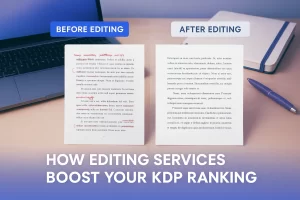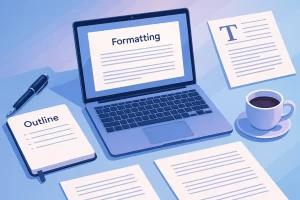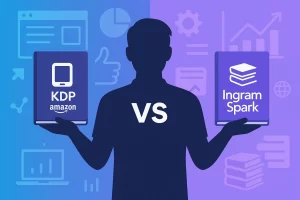If you are a self-published author who has recently established your publishing enterprise, but haven’t determined the right publishing route. You may find it a challenging task to adopt an appropriate publishing path. Authors have different publishing options; the most common publishing routes are traditional, self-publishing, or a hybrid path. Before getting involved in your market research to assess the pros and cons of adopting a lucrative publishing platform, you are required to focus on your budgetary needs, cost implications, and identify your publishing goals and resources.
A new traditional author, having insufficient publishing experience, seeks assistance from book writing services. With traditional publishing, they are not expected to pay any cost, as the publishing house manages publishing upfront costs ranging from book manufacturing to editing, book cover design, layout, and marketing. Though novice writers get lower royalty rates, they get a chance to increase manuscript discoverability by bringing their books into physical bookstores and libraries.
If you are an experienced author and a savvy book publisher, having a deep understanding of the publishing industry helps you adopt a flexible and seamless publishing process. Your industry expertise and knowledge of modern publishing strategies assist you in exploring self-publishing platforms and the publishing costs that you cover. The expenses vary from book production design, printing, digital distribution, and online marketing, which offer convenience and reliability. With a self-publishing model, independent authors establish their market expertise, improve their professional reputation, and expand book reach.
Another publishing platform that some publishers prefer is hybrid publishing. Since it combines traditional and self-publishing, the publishing cost requires the authors to pay for acquiring the publishing services such as professional editing, cover design, and distribution services. If an indie author requires ghostwriting services, they have to meet additional costs. Regarding opting for marketing and promotional services, hybrid publishers charge an additional amount for creating custom marketing campaigns for local and international book promotions. The authors pay these costs to receive a higher royalty rate and avail professional publisher’s support.
The Two Paths of Publishing in 2025
Traditional Publishers Manage Publishing Expenses
Whether you are a first-time author or a seasoned writer, leading traditional publishers, David McKay Publications, facilitates you by streamlining the pre-publishing process. The publishing house covers the entire upfront costs of manuscript production, editing, design, marketing, and distribution.
To assist authors with pre-publishing book marketing costs, the publishers cover book promotional costs for launching content marketing, email, and social media campaigns. The social media plan includes creating engaging posts with newsletters, book reviews, and book trailers that emphasize the book’s significance among potential readers. The digital marketing and publicity team also runs targeted ad campaigns and pre-order campaigns on Amazon and social media before the book release. For long-term manuscript promotion, the authors invest in creating an author website. They pay the cost for domain registration and web hosting, and also make a payment for a custom web design.
The other key costs include book launch and ongoing marketing campaigns. Professional authors also invest in seeking assistance from professional publishing services to organize and launch events. It includes hosting a book launch party, book tours, author signings, and speaking engagements. Thus, traditional publishers competently manage publishing expenses and help authors to maximize readers’ engagement and boost book sales across digital channels.
Self-Publishing / Hybrid Publishing
Self-publishing Mode
If you want to retain your creative control in book publishing and desire to have quick publishing and distribution of e-books, audiobooks, and print books globally, your preferred option should be adopting a self-publishing platform. A self-published author is responsible for undertaking every aspect of manuscript publishing. To develop a well-structured and refined book, the authors need to set a cost-effective self-publishing budget. It includes allocating an amount for book manufacturing. Prioritizing high-quality editing and creating alluring book cover designs requires indie authors to invest in hiring a freelance editor and illustrator. Book editing and design costs vary by professional experience and project scope of the manuscript. Professional editing involves multiple editing rounds comprising developmental editing that improves the structure and content. Line editing addresses flow and coherence in the context. Copyeditors review the manuscript in-depth to modify vocabulary, grammar, and syntax. The proofreaders finally check for typos and minor structural, formatting, and content errors before publication. As each editing round involves specialized editing expertise, the production and publishing costs accelerate.
Designing aesthetically pleasing professional book covers suggests that authors opt for an expert graphic designer or illustrator who creates quality custom book cover designs, images, and illustrations. The enchanting brushstrokes give voice to the author’s narration. The book cover design packages include both the e-book and print book cover designs.
Another significant advantage is receiving a higher royalty share. Indie authors receive 35% to 70% royalties on e-books and an estimated 40-60% earnings on print books based on the book’s sales. Thus, self-publishing gives authors absolute authority over their published work and enables them to establish their niche market worldwide.
Hybrid Publishing
Hybrid publishing, assimilating both traditional and self-publishing, offers professional support to hybrid authors to retain their creative control in editing and book cover designs. The authors invest in availing high-quality publishing services, comprising manuscript marketing and distribution of books to a global audience. Hybrid publishers also share the cost and risk of book publishing with authors. For this purpose, the authors invest an additional amount in production costs to cover book publishing risks. In return, hybrid publishers offer higher royalty rates than traditional models.
Core Costs of Self-Publishing a Book in 2025
Manuscript Development Cost
Publishing companies such as David McKay Publications assist authors with pre-publishing budget management. They facilitate authors in making appropriate costs for manuscript editing. Some authors allocate around $2,000 to $4,720 or more, depending on book genre, length, and scope. Moreover, the cost accelerates according to the specific publishing services the authors need. Let’s suppose that self-published authors require a comprehensive book editing service for an extensive book project. Accessing developmental editing services allows authors to spend around $1,500 – $5,000+. The editorial experts analyze sentence structure, plot, and dialogue. They improve the language, style, and tone of the manuscript. Eliminate redundant words and phrases, and add details that create consistency in paragraphs.
For extensive copyediting, self-publish authors spend around $800 – $2,500. Proficient editors identify grammatical, punctuation, and syntax errors and rectify them to enrich the narrative. The final review of the manuscript involves proofreaders and formatters to check the structural and formatting flaws in the book. The authors pay approximately $500 – $1,500 for conducting rigorous proofreading of the final version. It includes detecting typos and other minor errors in content and formatting before the manuscript is sent for print. Thus, a professional book editor meticulously reviews the manuscript to create a refined and captivating manuscript that adheres to professional editing standards.
Book Design & Formatting Cost
Creating eye-catching and visually pleasing book covers requires indie authors to allocate a budget for self-publishing book cover design. Different factors, such as the book’s length and placement of stock photos and custom-illustrated covers of e-book or print, the designer’s experience, and opting for a design cover service, upsurge book design cost. As indie authors exercise their creative autonomy in creating striking book covers, they use free design tools such as Canva to design DIY covers or create custom book cover designs. The cost of using DIY book covers, custom design, and utilizing template design covers is considered a budget-conscious design initiative for authors. The basic cover design cost, including DIY covers, ranges from $50 to $300.While professional custom cover designs cost varies from $200 to over $1,000.
The basic ebook formatting includes a front cover that costs $50 to $300, depending on the complexity of the publishing format. If an author intends to publish the manuscript in multiple formats, the publishing cost rises. For printing books, the cost of interior formatting, layout, and inserting illustrations cost$300 – $1,000. Additionally, the authors also pay the expense of hiring a freelance illustrator. The allocated amount varies from $1,540 to $4,950 or more based on the illustrator’s experience, the quantity and type of pictures the author needs to add in the e-book version.
ISBN & Copyright
If you are a startup publishing firm and intend to publish your manuscript using your resources, you need to know about ISBNs, copyright, and other legal procedures. The publishing team at David McKay Publications offers smooth and reliable publishing services. Along with printing, binding, and formatting, the experts also help new authors learn about the ISBN registration process. To facilitate novice authors, the publishing house purchases ISBNs on their behalf and manages the application process. If the authors have a single publication, the publishers order a bundle of ISBNs and provide individual identification codes to the authors at a set price. In case the writer has multiple formats of books, the publishers provide them with a separate 13-digit barcode for each format. The cost that authors are required to pay for a single ISBN acquisition is $125. To obtain separate ISBNs for different formats, the authors give $295 to publishers.
The provision of a standard identification code helps in classifying the author and publisher, book title, edition, and book format. The manuscript is registered within the relevant publisher databases, with barcode images. It increases book discoverability and further helps new authors to get tracked by retailers to enhance their professional presence.
To assist authors with work ownership rights, the publishing house provides relevant knowledge of copyright law and registration. They manage the application and registration process and personally pay the copyright office fees to the U.S. Copyright Office fees. The publishers recover the costs from the author in the form of a flat fee, such as $65–$100. or by abstracting the cost from royalties.
Printing & Distribution Costs
The print and distribution costs in the USA vary due to different factors. It includes large print quality, print type, high-quality paper, and premium materials used for manuscript printing and printing location. Self-published authors utilize Amazon KDP and IngramSpark for printing the required quantity of books through Print-on-Demand. Services. POD, a cost-effective printing method, prevents authors from paying the upfront printing cost. Instead, the POD printing costs vary by page count, trim size, paper type, and color possibilities. The authors approximately pay $4 – $6 per paperback copy.
Some authors prefer offset printing. Bulk printing benefits authors who require large print runs. As it is cost-effective, the authors make a higher upfront investment of $2,000 to $10,000, but they pay a lower per-copy cost. The charges for bulk printing, such as 1,000 copies of a paperback book of 300 pages, cost around $2 – $3 per unit. It is a lucrative printing option that brings high sales and revenue.
The e-book distribution is executed through self-publishing platforms such as Amazon KDP, Apple Books, Kobo, and IngramSpark. The online publishing platforms charge a fee for distributing the book to numerous bookstores and retailers. The amount extends $0 to $49, based on the platform and distribution options. The printing management company proficiently manages the entire printing process, from design, printing to free distribution of ebooks and print books. However, they take a small percentage of the retail price instead of upfront fees.
Marketing & Promotion Costs in 2025
Effective Book Marketing Campaigns
To meet the targeted marketing campaigns, the authors allocate $60–$1,750.The marketing experts at David McKay Publications collaborate with the authors to develop comprehensive book promotional strategies that enhance book visibility across the globe. The campaign comprises content marketing on the author’s website. The costs of website development vary depending on the different services the author opts for. For instance, they set aside a budget of around $60 to $500/year for website hosting. For website design, they allocate $500 – $2,500 annually. To design professional website logos and media kits, the authors reserve an amount $200 – $1,000.
Launching social media campaigns requires marketers to save an amount from $500 to $2,000/month for posting blog posts and social media posts. For increased social media management, adding email newsletters, book reviews, and video content, the authors maintain a balanced budget, approximately $2,000–$5,000. Moreover, preparing striking book trailers and running on various social media sites requires authors to spend a sum of around $500 – $2,500.
To run social media ad campaigns on Facebook, Instagram, and TikTok, the authors allocate $300 to $2,000+. Self-published authors keep $5 daily budget to run free or paid ads on Facebook and Amazon ads. As their published manuscript gets more visibility, the authors can increase their targeted budget.
Book Launch Events Cost
The book launch cost ranges from selecting free or low-cost venues to host pre-launch events. The authors organize book signings, exhibitions, and other events in physical bookstores, libraries, or other venues. Virtual events such as book tours, podcasts, author readings, and Q/A sessions are conducted online or on social media.
Publicity & PR
Book publicity implies that authors allocate a budgetary amount ranging from $7,500 to $20,000. For instance, the authors utilize $2,000 – $10,000+.for for hiring a professional book publishing service or book publicist. The total cost may exceed, depending on the service’s scope, campaign intensity, the publicist’s vast experience, and reputation. To manage media outreach, the author establishes a strong network with journalists, bloggers, and other influencers. The increased media coverage allows self-publishing authors to keep a budget for acquiring paid distribution services that assist in writing press releases and disseminating press statements to broader media networks. The basic cost of obtaining press release services is around $150 – $500. For wider distribution, the author needs to spend an amount extending from $300 to $1000.
ARC (Advance Review Copy) Distribution & Email Campaign Cost
An author covers ARC expenses (Advance Review Copy) for distributing the released physical and digital copies to reviewers and influencers, and promotes the manuscripts through email campaigns. For ARC distribution and launching extensive promotional email campaigns, the author allocates an amount from $100 to $500+depending on the book’s genre, the size of the audience, and influencers’ promotional activities.
Other Optional but Valuable Costs
Audiobook Production
The authors also keep an allocated budget to avail the additional book publishing services. It includes an audiobook production. The remarkable audiobook publishing services offered at David McKay Publications guide authors to make effective budgeting to get access to expert narration, high-quality audio production, and seamless distribution. The total estimated cost ranges $2,000 to $7,000. To acquire professional audio production service, the authors grant $500 to $7,000 to a publishing house to handle the complete production process. The production costs are evaluated according to both length and per finished hour, ranging between $200- $500.The total cost of narration, editing, and distribution is estimated at $250 to $500 per finished hour.
Translation for Global Markets
The other expenses that the author covers include the translation of books in the global markets. The author pays the cost $0.10 – $0.20 per word or up to to5,000 for a full-length manuscript. The cost increases depending on languages, per word, the translator’s experience, and the category of books, such as technical or literary books.
Workshops & Professional Guidance
To increase the author’s visibility in the publishing industry, the authors attend specialized workshops. Professional seminars and conferences help authors learn publishing skills and promote their publications on online platforms. The cost of a full-day workshop is estimated at around Rs 1500 per person, while a short workshop costs between $6,000–$12,000.The authors hire professional book coaches or publishing consultants with an estimated cost of $500 – $3,00 and more based on the consultant’s work experience and knowledge.
Recapitulate
Planning a detailed breakdown of publishing costs enables authors to create a smart budget. A savvy book publisher prepares a comprehensive pre-publishing budget that allows new publishers to access marketplaces to find experienced publishing companies or hybrid publishers that provide complete publishing services. The standard editing cost that authors pay is estimated at $1,000 per 10,000 words, which involves multiple rounds of editing. Developmental editing is the most expensive type of editing as the editing supervisor evaluates the manuscript’s structural and narrative issues, improving plot, pacing, character arcs, theme, and enriching the settings. The final stage of proofreading involves the authors allocating an amount, $500 – $1,500, for proofreaders to meticulously check typos and other remaining errors in grammar, punctuation, and formatting before publication. The allocated amount for book cover design varies from $0 for creating DIY book covers to over $1,000 for generating a custom, high-quality design. While authors also pay around $150 or more to hire freelance cover designers to deliver professional-level design services.
The book marketing costs include developing a strong content marketing strategy, book promotion on Amazon, social media campaign, and comprehensive book launch activities and pre-order campaigns. Since self-publish authors print books independently, they have to manage printing costs ranging from binding of paperback and hardcover, printed copies with black and white content, and bulk printing.
Self-published authors utilize online publishing sites to create multiple publishing and printing formats. They utilize cost-effective print-on-demand book services that include lower publishing costs and produce high-quality publications that match industry standards. The authors also evaluate optional and significant costs comprising audio book production and translation of books for global markets. With budget management, the authors track publishing costs and evaluate book sales revenue and royalties. Effective budgeting empowers authors to avoid unexpected expenses and financial hassles during the publishing process. Thus, help authors with strategic financial planning to meet their publishing goals.




